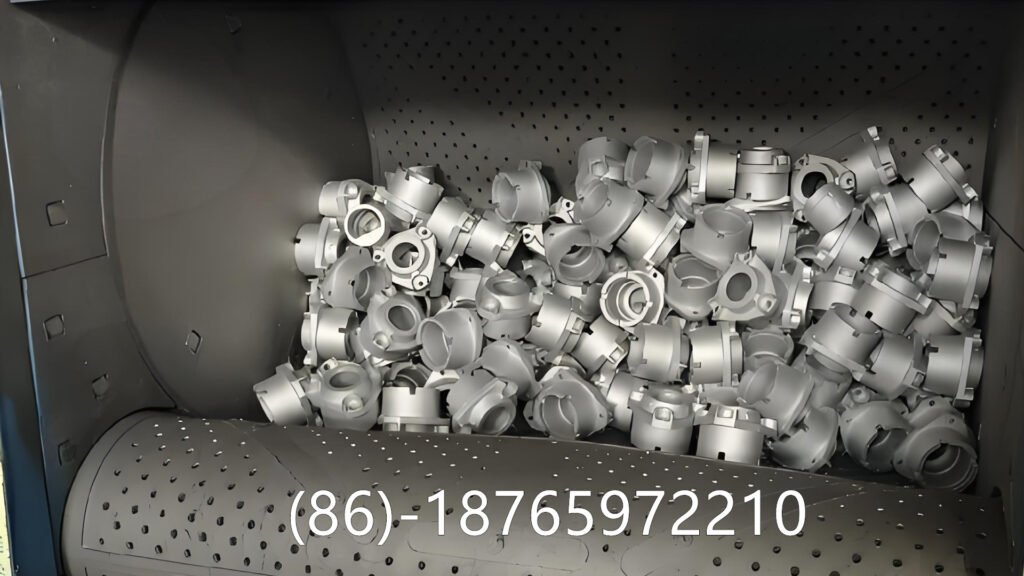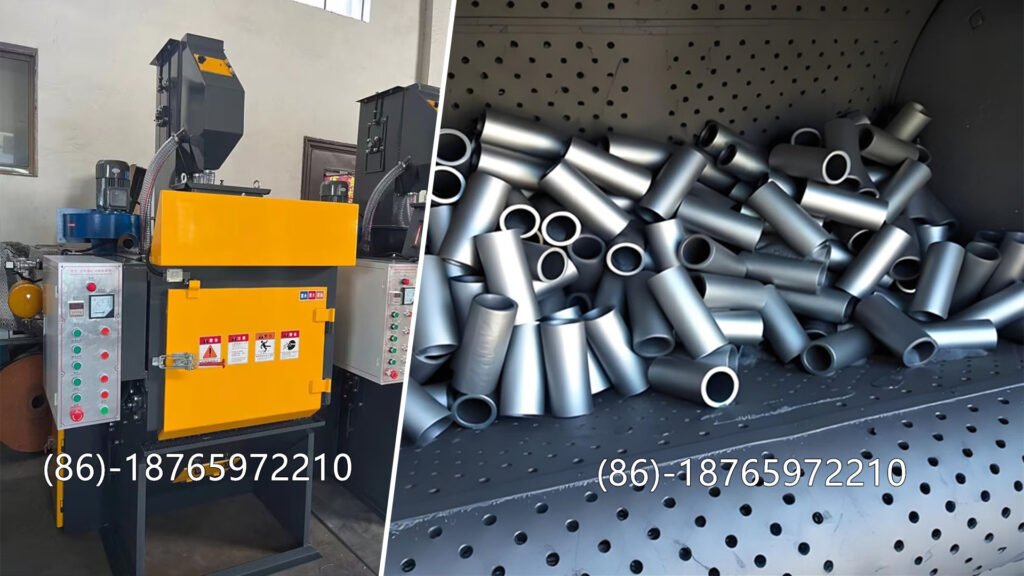General Description
Tumble shot blast machine is used for surface cleaning of bulk small and medium workpieces. Parts are placed inside a rotating drum (steel belt or rubber belt type). While tumbling, abrasive shot is thrown by the blast wheel to remove rust, oxide layer, and molding sand. After cleaning, surface roughness is uniform and suitable for painting, coating, or further machining.
Machine is designed for batch production. It is not suitable for large, fragile, or easily deformed parts.
Tumble Shot Blast Machine Core Structure: Main Components
Cleaning Chamber: Welded steel structure lined with wear-resistant protective plates (Mn13 Cr21 high-manganese steel,has good corrosion resistance), carries workpieces and protects the equipment.
Rubber/Manganese Steel Tracks: Load workpieces and rotate them (rubber tracks offer excellent elasticity and low noise; manganese steel tracks are impact-resistant).
Cantilever Centrifugal Shot Blaster: Projectile speeds reach 75-85 m/s (equipment with a BE-type separator), with the impeller rotating at high speed to eject the shot.
Shot Circulation System: Includes a screw conveyor, bucket elevator, and separator to recycle and reuse steel shot.
Dust Removal System: Bag dust collector or pulse backflush device, dust emissions meet national standards (concentration ≤ 50 mg/m³).

Tumble Shot Blast Machine Workflow
Loading: Workpieces are loaded onto the tracked drum, and the sealing door is closed.
Shot Blasting: The shot blaster starts, projecting shots from the top, evenly impacting the workpiece surface. Simultaneously, the drum drives the workpiece to ensure full coverage.
Shot Recovery: Waste materials (shot, scale, etc.) fall through the track holes into a screw conveyor, then an elevator, and finally a separator (which separates qualified shot from impurities).
Discharging: After cleaning is complete, the track reverses or the door opens to discharge the material. Dust is filtered and discharged through a dust collector.
Application Range
- Castings: iron, steel, aluminum alloy
- Forgings: gears, fasteners, tools
- Heat-treated parts: springs, bearing rings
- Other bulk pieces: small welded parts, hardware components
Generally, each piece should not exceed 15–30 kg depending on model, otherwise tumbling effect is reduced.
Typical Parameters
(Values vary by machine size; below for reference only)
- Drum load: 200–1000 kg per batch
- Drum diameter: 650–1200 mm
- Blast wheel power: 11–22 kW (single or dual wheel)
- Cleaning time: 15–25 min per batch
- Abrasive flow: 120–250 kg/min
- Dust collector air volume: 2500–8000 m³/h
When selecting model, consider part size, weight, and production output, not only rated load.
Operation Notes
- Loading: Do not exceed rated drum weight. Overloading reduces blasting effect and damages belt or liners.
- Part suitability: Avoid long rods or thin sheets. Such parts can bend or get stuck during tumbling.
- Abrasive: Recommended shot size 0.8–1.5 mm. Too fine causes low impact, too coarse may damage surface.
- Maintenance:
- Check blast wheel liners and impeller every week.
- Inspect separator and abrasive circulation, remove impurities.
- Check belt or drum for wear, replace if cracks appear.
- Dust system: Monitor filter pressure drop. Clean or replace cartridges in time, otherwise suction will decrease.

Tumble Shot Blast Machine – Common Issues & Solutions
1. Uneven Cleaning Quality
Issue: Some parts not fully cleaned, surface still has rust or sand.
Cause: Overloading drum, improper part size, or shot distribution not balanced.
Solution:
- Keep within rated load capacity.
- Avoid long or flat parts that don’t tumble well.
- Adjust blast wheel angle and check separator for proper shot flow.
2. Belt / Drum Wear Too Fast
Issue: Rubber belt or steel drum liner wears out quickly.
Cause: Overload, sharp-edged workpieces, or poor abrasive quality.
Solution:
- Use correct batch size and weight.
- Inspect workpieces, avoid sharp burrs when possible.
- Use clean, round abrasive to reduce cutting wear.
3. High Dust Emission in Workshop
Issue: Dust seen around machine or filter pressure too high.
Cause: Filter bags/cartridges clogged, suction not enough.
Solution:
- Clean or replace filters regularly.
- Check ducting for leakage.
- Ensure dust collector fan working at rated air volume.
4. High Abrasive Consumption
Issue: Steel shot usage too high, operating cost increasing.
Cause: Separator not working well, too much broken shot, or airwash not adjusted.
Solution:
- Adjust airwash separator airflow.
- Remove oversized contaminants.
- Replace worn impeller parts that break shot prematurely.
5. Abnormal Noise and Vibration
Issue: Machine running with strong vibration or knocking sound.
Cause: Blast wheel imbalance, loose liners, or foreign objects inside drum.
Solution:
- Stop machine immediately for inspection.
- Check blast wheel impeller and control cage for wear or imbalance.
- Tighten liners and remove any foreign parts inside.
6. Parts Damaged During Cleaning
Issue: Workpieces bent, cracked, or surface roughness too high.
Cause: Wrong part type loaded, abrasive size too large, blasting time too long.
Solution:
- Only clean parts suitable for tumbling (no thin sheets or fragile castings).
- Select proper abrasive size (0.8–1.2 mm for general casting).
- Optimize blasting cycle time based on part type.
✅ Summary:
Most problems come from overloading, wrong part selection, abrasive quality, and insufficient maintenance. With correct operation and routine inspection, tumble shot blast machine can keep high efficiency and low running cost.

